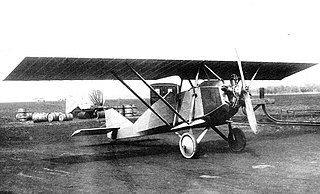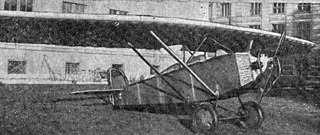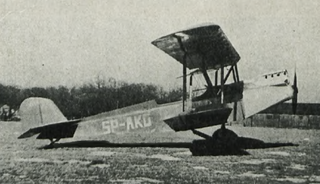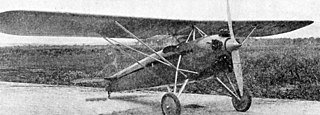| Sido 1 | |
|---|---|
 | |
| Role | Trainer aircraft |
| National origin | Poland |
| Designer | Józef Sido |
| First flight | late July 1930 |
| Number built | 6 |
The Sido S.1 was a Polish two seat, parasol wing trainer aircraft, first flown in 1930.
| Sido 1 | |
|---|---|
 | |
| Role | Trainer aircraft |
| National origin | Poland |
| Designer | Józef Sido |
| First flight | late July 1930 |
| Number built | 6 |
The Sido S.1 was a Polish two seat, parasol wing trainer aircraft, first flown in 1930.
In the late 1920s the LOPP issued a requirement for a low cost, 60 kW (80 hp) club trainer. In 1929 the Sido S.1 was designed in response by the amateur Józef Sido, who was a student at the Mining Academy in Kraków. Positive reactions from both LOPP and the Kraków Academic Aeroclub led to the parallel construction of three airframes in the workshops of the local Air Regiment, differing primarily in their engines. The first, powered by a 63 kW (85 hp) Cirrus III inline, flew for the first time on ether 21 [1] or 28 July 1930. [2] The second airframe flew in September 1930, initially known as the S.2 and fitted with a 60 kW (80 hp) Avia W.Z.7, a Polish seven cylinder radial engine. The third, initially known as the S.3, had the Cirrus engine but had modified the wing bracing struts and undercarriage. In the late summer of 1931 the two later aircraft were modified to the standards and engine of the S.1 and were referred to by that designation. [1] [2]
The wooden parasol wing of the Sido S.1 was built in two parts. Each had two spars, plywood skinned leading edges and was fabric covered. In plan the wing was straight tapered and its section varied outboard from S.T.Ae 74 to Göttingen Gö 398. Each halfwing was joined to the lower fuselage longerons with V-struts to the spars and the centre section, formed from the fuel tank, was held well above the fuselage on steel tube struts to the upper fuselage. [1]
Its flat-sided fuselage was built around a steel tube structure and fabric covered apart from plywood decking. There were two open, tandem cockpits equipped with dual control. The upward field of view from the rear cockpit was improved with a wide, rounded, trailing edge cut-out and access to the front cockpit with a starboard-side door. The S.1 had a triangular fin and a large rudder with a leading edge that extended the straight edge of the fin but with a full, rounded trailing edge down to the keel. The tailplane was mounted on top of the fuselage, strut braced from below, and the elevators had a cut-out for rudder movement. [1]
The S.1 had conventional, fixed landing gear. Each maninwheel was on a half-axle hinged from the lower fuselage longeron, as was the radius arm. The landing leg, which incorporated a compressed rubber shock absorber, was hinged from the upper longeron. [1]
The Polish military aviation authorities considered the S.1 alongside the PZL.5 and the M.N.5 for their trainer requirements. Despite its good performance, the lack of an established manufacturing facility for this amateur design prevented its military adoption. There was more enthusiasm from the civilian aeroclubs and a series of five airframes, designated S.1bis Z, powered by the Avia engine in a Townend ring cowling and fitted with streamlined wing struts, was begun in the newly established Central Aeroclubs' Workshops (C.W.A.). C.W.A went bankrupt after producing only three, the last of which had a 60 kW (80 hp) Siemens-Halske Sh 11 radial. [1]
The S.1s was a frequent competitor in Polish meetings, including the National Lightplane Contests and many local and regional meetings and rallies through the early 1930s, though without major successes. It also served as a reliable and forgiving club trainer, the small production numbers reflecting the failure to find an established constructor for the aircraft rather than its qualities. [1] One remained in use until 1939 [1] and may have been evacuated to Romania. [2]
Data from J. Cynk (1971) [1]
General characteristics
Performance

The PZL-5 was a Polish two-seat touring and sports aircraft of 1930 constructed and produced by the PZL.

The Lublin R-X was a Polish single-engined, two seat liaison aircraft, built in 1929 in the Plage i Laśkiewicz factory in Lublin. Seven were completed, two of them prototypes. Four served with Polish air regiments and another made several notable long flights and tours.

The RWD 23 was a Polish low-wing trainer aircraft of 1938, constructed by the RWD team, that remained a prototype.

The RWD 16bis and RWD 21 were Polish two-seat low-wing touring and sports planes of the late 1930s, constructed by the RWD bureau, sharing the same construction, main difference of the RWD 21 being a stronger engine.

The PWS 3 was a Polish sport aircraft, developed in 1927 by PWS, which remained a prototype.
The Medwecki and Nowakowski M.N.3 or just M.N.3 was a low-powered, four seat, Polish aircraft flown in 1928. The sole example was modified into a more powerful two-seater which served aeroclubs until World War II.

The Medwecki and Nowakowski M.N.5 was an economical Polish trainer aircraft initially aimed at the club market, though there was also some military interest. It performed well but lacked a constructor after Samolot became insolvent in 1930, so only one was completed.

The Rogalski and Wigura R.W.1 was designed and built by a pair of students at Warsaw Technical University in 1927. The single example was a two-seat parasol-wing monoplane which entered two national competitions, served the Warsaw Academic Aeroclub and also towed an advertising banner.
The Gabriel P 6 was a Polish training aircraft and the P 7 a tourer. The difference between them was the wing configuration, chosen to optimise their speed range for their role, so the P 6 was a biplane and the P 7 a parasol wing aircraft.
The Silesia S-4 was a Polish, low-power parasol wing aircraft built in 1925. After an engine change and airframe modifications it became one of the Silesian Aeroclubs fleet. It was lost in a take-off accident in 1931 and was the last Silesia aircraft to fly.
The D.K.D.3 was a Polish, single seat, parasol-wing sports aircraft first flown in 1927. Only one was built but flew in demonstrations and in national competitions into the early 1930s.
The Działowski D.K.D.4 was a Polish, parasol-wing, sports two-seater built in 1928. One won the Second National Lightplane Contest, with another coming fifth.

The Zalewski W.Z.XII Kogutek II was a Polish single-seat sports aircraft. Construction was started in 1932 but not completed and flown until 1937. Only one was built.

The all-wood Kozłowski WK.1 Jutrzenka (Dawn) was a two-seat low wing monoplane designed and built in Poland over 1926-7.

The Kozlowski WK.3 was a one-off Polish biplane trainer. It first flew in 1933 and was later re-engined, serving an aeroclub until the invasion of Poland.
The Ostrovia II or Moryson II was a 1930s Polish club trainer aircraft, a development of the Ostrovia I. Only one was built and was used by the Poznań flying club for five years.
The LKL IV and LKL V were a pair of very similar Polish parasol wing two-seaters, built in the early 1930s. They differed primarily in their engines.
The Medwecki M9 was a 1930s, Polish designed two-seat cabin tourer or trainer aircraft. Only one was completed before the outbreak of World War II.
The Ścibor-Rylski ŚR-3 was a Polish, ultralight, low power, single-seat sports aircraft. First flown in August 1939, only one was completed before World War II.

The Inland Sport series of parasol wing, sport and training side-by-side two seaters, introduced between 1928 and 1930, differed chiefly in their engines. They used three different radial engines, more than doubling the Sport's power over two years of development. 34 examples were built and frequently re-engined.